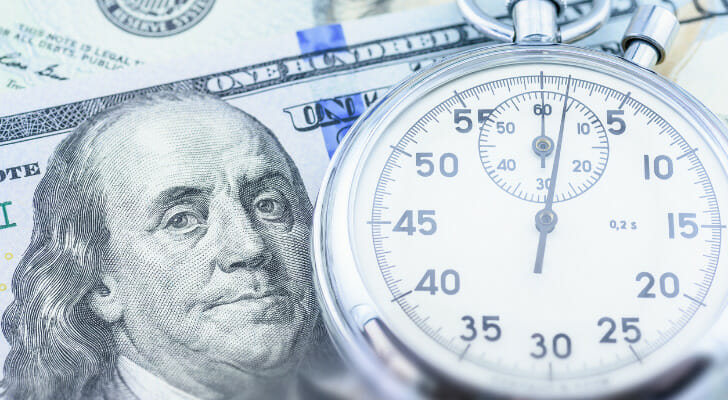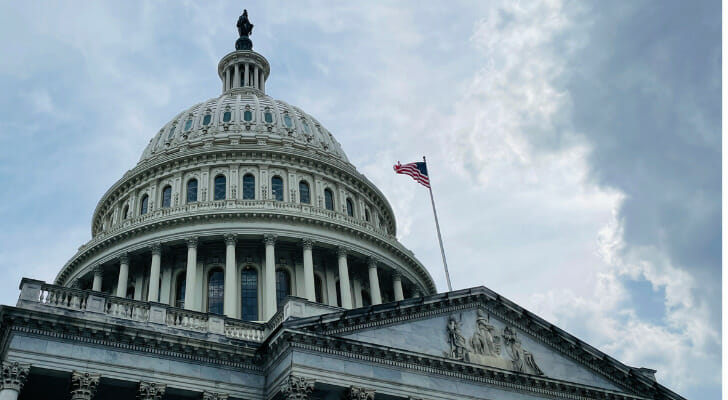Get ready for the trillion-dollar question: Are your Treasury bonds at risk in the face of a U.S. default? Brace yourself, because if Congress falters in raising the debt ceiling before the Treasury’s coffers run dry, the repercussions will be felt far and wide. When the government can’t foot its bills, that includes honoring payments on Treasury debt—bonds, bills and notes included. Discover the potential impact on your investments and protect your financial future.
A financial advisor can help you navigate this precarious moment. Find a fiduciary advisor today.
If you own Treasury bonds, there’s a very good chance that this will reduce the value of your investment. While the government will ultimately pay all of the interest and par value that you are owed, a default might delay those payments. It will also very likely reduce the value of your bonds on the secondary market, generating a lower return if you choose to sell them.
Here’s why.
Despite its misleading name, the debt limit does not actually limit government debt. Instead, it limits the Treasury’s ability to restructure that debt as necessary.
The total amount that the United States owes is established each year through Congress’ tax and budget process. In the annual budget, Congress makes millions of individual commitments to soldiers, sailors, teachers, air traffic controllers, corporate vendors, foreign governments and countless others. When tax revenues fall short of these commitments, the result is the total debt of the U.S.
To consolidate this debt, the Treasury issues bonds. These instruments shift the government’s obligations from a network of countless ad hoc creditors to a series of structured lenders on a fixed repayment schedule. Bonds give the Treasury the cash flow it needs to pay the bills that Congress has incurred, including past bills such as bonds issued in previous years.
The debt ceiling puts a cap on how many bonds the Treasury can issue. This eliminates its ability to restructure and consolidate, choking off the Treasury’s cash flow without affecting the government’s underlying debt.
What Will Happen to Bondholders If the Debt Ceiling Isn’t Lifted?
It’s difficult to tell exactly because this never happened before. However there are some likely results.
Investors who hold U.S. Treasury bonds are one of the great network of creditors to whom the government owes money. In their case, the government owes them regular interest payments and lump-sum repayments for matured assets. The Treasury issues these payments on a regular schedule, based on the nature of any individual asset.
Once in default, the Treasury will likely begin prioritizing payments, sending checks to some creditors while defaulting on others as cash rolls in. Among other things, in the same way that an unpaid power bill leads to penalties and fines, an extended default would likely result in penalties and lawsuits as individual creditors seek the money they are owed.
For bondholders, this could result in several significant outcomes.
First, no new assets to purchase.
Investors in U.S. debt will not be able to purchase new assets while the government is in default. The debt ceiling means that the Treasury is barred from issuing new debt instruments, so it will not sell new bonds until that limit is raised.
That does not mean that you can’t buy any Treasury bonds, just that you won’t have access to newly created and issued ones.
Second, payment disruptions are possible but unlikely.
If the Treasury has to structure payments due to cash flow issues caused by the debt ceiling, it’s likely that it will try to prioritize existing debt holders in an effort to preserve as much of the government’s credit and credibility as possible. If it has the cash on hand to do so, the Treasury will then continue issuing interest and repayments for existing bonds on schedule.
The problem is that the Treasury owes more than $1 trillion in maturity and interest payments over the course of June. It is unlikely to have this cash on hand in the absence of new borrowing.
In the event of a brief default, lasting hours or days, bondholders will probably not see any interruption in their payments. If a default lasts longer than that, the risks of a missed payment will increase, becoming a near-certainty if the government remains in default over a period of several weeks.
Third, your returns will likely suffer.
The yield on your bonds will likely be safe, even in the event of a payment disruption. However you can likely expect lower returns if you choose to sell your bonds.
If Congress defaults on the U.S. debt, it will almost certainly reduce the market value of this debt at every level. Much of the value behind these bonds is their perception as the world’s safest asset, guaranteed by both law and tradition. That confidence, once shaken, will not be easily restored. Secondary markets will almost certainly price this risk into Treasury bonds.
Beyond that, once in default credit agencies will downgrade U.S. debt. If that happens Treasury bonds will no longer meet the minimum standards for many low-risk funds and institutions, forcing them to sell their assets and flooding the market with Treasury bonds. Collectively, this will reduce the amount that buyers pay for Treasury assets, reducing the returns you can expect if you choose to sell your bonds. It will also likely push up the value of long-term bonds over short-term bonds, as investors seek the perceived security of assets that mature after the immediate default crisis has passed.
Fourth, interest rates will go up.
This is a double edged sword for investors.
As noted above, much of the value behind Treasury bonds is the idea that they are the world’s safest asset. This is priced into their interest rate. If Congress defaults on the U.S. debt it will introduce risk into Treasury borrowing. As with all debt, lenders charge higher interest rates for riskier assets. The result is that, once the debt ceiling is lifted, the Treasury will almost certainly have to pay higher interest rates for newly issued bonds.
For new investors, this will be a bit of rare good news. They will likely get better yields on new Treasury bonds going forward. For existing investors, however, this will devalue the bonds they currently hold, pushing down their value on the secondary market relative to new, higher-interest assets.
Returning to our original question, are your Treasury bonds safe? The answer is mixed.
If you are a long term investor whose goal is to collect interest payments until an asset’s maturity, then your investment is probably safe. You may see a brief disruption in your bonds’ repayment schedule, but that is unlikely to last very long. Beyond that, it is still extremely unlikely that you will lose money on this asset.
If you want to sell your bonds at any point, you will very likely lose money. The value of existing bonds will almost certainly fall (possibly quite significantly) in the event of a default.
If you are a future investor, you will probably improve your yields as the increased costs of U.S. borrowing push up the interest rates on future Treasury bonds.
But it’s critical to understand that this is entirely speculative. A U.S. default would cause chaos across every financial market, from investments to employment to borrowing and beyond. Borrowing and credit of every kind would get more expensive, likely pushing up prices in most markets and pushing prices down on most investments. There is no clear way to predict what would happen in this environment, even if these are a series of likely outcomes.
The Bottom Line
If Congress defaults on the U.S. debt, the first assets hit will be Treasury bills, bonds and notes. For current investors this will likely mean chaos. You can most likely expect Treasury payments in full, even if not on time, but secondary market returns will almost certainly plummet.
Risk Management Tips
- Even if Treasury assets are supposed to be immune from risk, it’s still a part of investing overall. Managing that is a key part of managing your money.
- The best way to prepare for risk is with good advice. A financial advisor can help. Finding a financial advisor doesn’t have to be hard. SmartAsset’s free tool matches you with up to three vetted financial advisors who serve your area, and you can interview your advisor matches at no cost to decide which one is right for you.
Photo credit: ©iStock.com/William_Potter, ©iStock.com/Douglas Rissing

